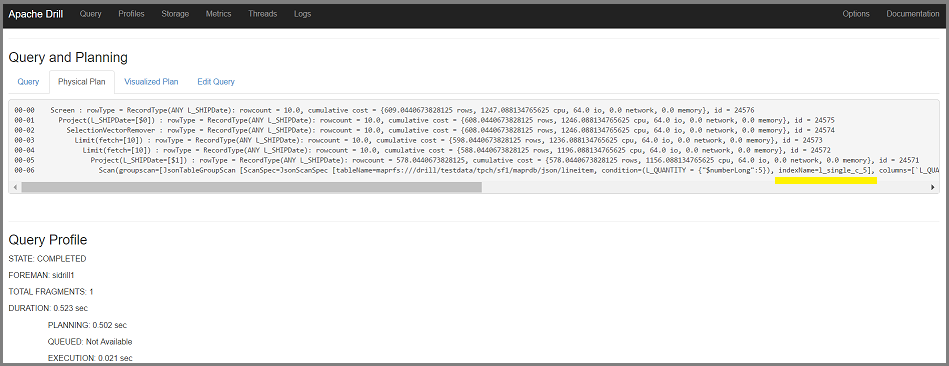Determining Index Use
Evaluate the query plan to analyze query performance and determine if Drill uses indexes. You can view query plans in the Drill Web Console or through the command line using the EXPLAIN command. You can also disable the indexing option in Drill and compare an index-based plan to a full table scan plan.
Drill leverages indexes during the physical planning phase of the query. Drill estimates the cost of an index-based plan and a plan that includes a full table scan. See Selection and Execution of Secondary Indexes for information about how Drill selects a query plan. In cases where Drill does not select the index-based plan and instead selects a full table scan plan, you may want to remove the indexes to free up storage space and eliminate the overhead of the indexes.
The following example shows you how to determine if Drill selected an index-based plan for a query through the query profile in the Drill Web Console and the EXPLAIN PLAN FOR output.
Example
The subsequent sections assume that an index exists on a table named "lineitem." The index, l_single_c_5, is a single field index created on the L_QUANTITY field. The index also covers the L_SUPPKEY, L_DISCOUNT, L_SHIPDate, and L_SHIPMODE fields. If a query contains fields covered by the index, the query is a covering query. If a query contains fields not covered by the index, the query is non-covering and requires a lookup back into the primary table to retrieve data.
- Table name: lineitem
- Index name: l_single_c_5
- Indexed field: L_QUANTITY
- Included fields: L_SUPPKEY, L_DISCOUNT, L_SHIPDate, L_SHIPMODE
Query Profile
View the query plan on the Profiles tab in the Drill Web Console. See Starting the Web Console. Select the query you want to evaluate and then select the Physical Plan tab. You can see the physical plan that Drill used to execute the query.
SELECT L_SHIPDate FROM lineitem WHERE L_QUANTITY = 5;
In the plan, you can see that Drill scanned the index, l_single_c_5, instead of the primary table. The query was completely covered by the index because the index contains all fields referenced in the query and the query filtered on the indexed field.
EXPLAIN PLAN
Alternatively, you can issue the EXPLAIN command to see how Drill executes a query. To see the chosen physical execution plan for a query without running the query, issue the EXPLAIN PLAN FOR command. This command shows you if Drill plans to use the index when executing the query.
EXPLAIN PLAN FOR SELECT L_SHIPDate FROM lineitem WHERE L_QUANTITY = 5 LIMIT 10;
+------+------+
| text | json |
+------+------+
| 00-00 Screen
00-01 Project(L_SHIPDate=[$0])
00-02 SelectionVectorRemover
00-03 Limit(fetch=[10])
00-04 Limit(fetch=[10])
00-05 Project(L_SHIPDate=[$1])
00-06 Scan(groupscan=[JsonTableGroupScan [ScanSpec=JsonScanSpec [tableName=maprfs:///drill/testdata/tpch/sf1/maprdb/json/lineitem, condition=(L_QUANTITY = {"$numberLong":5}), indexName=l_single_c_5], columns=[`L_QUANTITY`, `L_SHIPDate`]]])Compare Plans
If you want to compare an index-based plan against a plan with a full table scan, disable the planner.enable_index_planning option in Drill, and run the EXPLAIN PLAN FOR command for the query. Running this command with the planner.enable_index_planning option disabled forces Drill to generate a plan that includes a full table scan. You can compare the full table scan plan against the index-based plan to compare the costs and resource consumption of each plan.
EXPLAIN PLAN FOR SELECT L_SHIPDate FROM lineitem WHERE L_QUANTITY = 5 LIMIT 10;
+------+------+
| text | json |
+------+------+
| 00-00 Screen
00-01 Project(L_SHIPDate=[$0])
00-02 SelectionVectorRemover
00-03 Limit(fetch=[10])
00-04 Limit(fetch=[10])
00-05 Project(L_SHIPDate=[$1])
00-06 Scan(groupscan=[JsonTableGroupScan [ScanSpec=JsonScanSpec [tableName=maprfs:///drill/testdata/tpch/sf1/maprdb/json/lineitem, condition=(L_QUANTITY = {"$numberLong":5}), indexName=l_single_c_5], columns=[`L_QUANTITY`, `L_SHIPDate`]]])ALTER SESSION SET planner.enable_index_planning = falseEXPLAIN PLAN FOR SELECT L_SHIPDate FROM lineitem WHERE L_QUANTITY = 5 LIMIT 10;
+------+------+
| text | json |
+------+------+
| 00-00 Screen
00-01 Project(L_SHIPDate=[$0])
00-02 SelectionVectorRemover
00-03 Limit(fetch=[10])
00-04 UnionExchange
01-01 SelectionVectorRemover
01-02 Limit(fetch=[10])
01-03 Project(L_SHIPDate=[$1])
01-04 Scan(groupscan=[JsonTableGroupScan [ScanSpec=JsonScanSpec [tableName=maprfs:///drill/testdata/tpch/sf1/maprdb/json/lineitem, condition=(L_QUANTITY = {"$numberLong":5})], columns=[`L_QUANTITY`, `L_SHIPDate`]]])
|